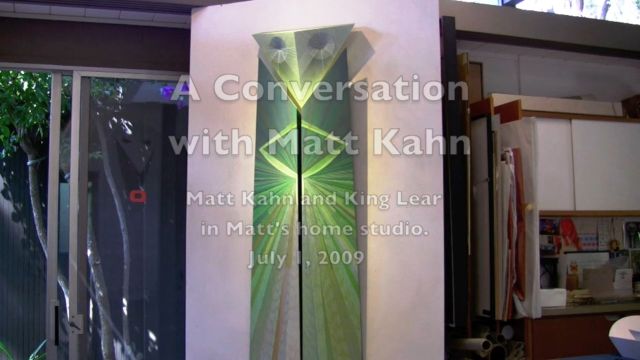
Video Features Eichler’s In-House Artist
 |
|
|
Joe Eichler is famed for his commitment to advanced and livable residential architecture. He is known as well for his commitment to providing housing for all, no matter race. But he’s less well known for another commitment – to the visual arts.
No, you won’t find a Joe and Lilliane Eichler Gallery at the de Young Museum. And Joe was not an important art collector.
Instead, Joe promoted art as an integral part of daily life, by emphasizing to the buyers and the sellers of his homes, and to the world at large, that the homes could serve as vessels for art, as living and working spaces for artists both professional and amateur, and as art objects in themselves.
This aspect of the Eichler Homes company is brought to life in a video interview that was recently posted online with Matt Kahn, who functioned much like Eichler’s artist in his residences.
 |
|
|
The film, 'A Conversation with Matt Kahn,' which clocks in at just under 30 minutes, was filmed in 2009 by King Lear, who both conducted the interview in an affable manner and handled the camera – if 'handling' can be used for setting the camera on a tripod and turning it on.
It is part of a longer interview that deals as well with Kahn’s own career as an artist. This shorter conversation relates to Kahn’s work with Eichler, and to his thoughts about Eichler homes.
The video was produced for the Los Altos Neutra House Project, a restored and re-purposed home designed by Richard Neutra and used today for events and conferences. It is dedicated to furthering knowledge of modern architecture. Lear is the Neutra House's volunteer director.
Kahn lived for decades in an Eichler home on the Stanford campus, where he was a professor in design. His career there was long, more than 60 years; he began teaching at the university in 1949 at age 21.
Lear too lived in an Eichler home for years, buying his first home, an Eichler in Sunnyvale, in 1964.
 |
|
|
Not only did Matt Kahn, working with his wife, textile artist Lyda Kahn, design interiors for Eichler’s model homes for a decade, starting in the early ‘50s, but Kahn designed Eichler brochures and ads and other materials.
On top of that, Eichler persuaded Kahn to lecture to the company’s salespeople about art, “so that they would be more sophisticated,” Kahn says in the interview.
How many tract developers did something like that?
“[Eichler] was very courageous, it seems to me,” Lear says to Kahn at one point.
“I think he was,” Kahn agrees.
“A very complicated person. Not a simple man,” Kahn recalls of Joe. “The people who worked for him saw him as something of a driver. He saw himself much more of a liberal. His associations with labor issues, let us say, were more philosophical than his relations with working people. He had a good sense of humor, a lot of sense of personal style. He loved color, especially in that context, like clothes.”
Kahn cautions Lear about the frailties of memory.
“You’re asking me to remember things that I may remember inaccurately. So I don’t want to tell you that any of this is fact. But it is my perception of what was going on.”
One such anecdote that Kahn retells – a secondhand tale at that – illustrates how memories may be fables. He tells of a time that Eichler purportedly drove the master, Frank Lloyd Wright, to see one of Joe's subdivisions. “It was time for Joe to show Frank Lloyd Wright what he was doing,” Kahn says.
 |
|
|
Joe had always been inspired by Wright’s work, since living in a Wright-designed home, and Joe’s architects took inspiration from Wright too. But was that inspiration misplaced?
Upon seeing Eichler's homes, Kahn says, “Frank Lloyd Wright is said to have put his hands to his head and said, 'My God, what have I done!?'”
More believable are Kahn’s memories of why and how he and Lyda Kahn did model interiors for Eichler.
King suggests one challenge facing Eichler and his salespeople, who needed to demonstrate to potential buyers “what life might be like in this non-traditional environment.”
Kahn responds, “In that sense the models became instructive, almost educational.”
Today, when mid-century modern homes come on the resale market, savvy stagers pull out the standard Eames and Nelson classic modern furnishings. The Kahns did not.
Kahn has always argued that Eichler homes are “permissive,” capable of housing objects of a wide variety of periods and styles, as long as they are objects with integrity.
“Certainly [things] that are done, with this genuineness and this integrity, work – and this can be textiles, this can be furniture. Certainly some of the early American things, oak things, are very happy in an Eichler home,” Kahn tells Lear.
 |
|
|
Lear met Kahn after Carroll Rankin, an architect who helped put the Palo Alto Eichler tracts Greenmeadow and Green Gables on the National Register and was also involved with the restoration of the Neutra House, suggested that Kahn would be a great interview subject.
“We got to be kind of instantly good friends,” Lear recalls.
Kahn died four years after the interview, at age 85.
“We really did admire Matt,” Lear says. “It was a really special connection.”
- ‹ previous
- 608 of 677
- next ›



